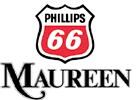


From the start the commitment by the Maureen owners was to carry out all the decommissioning activities in an environmentally responsible manner. Numerous surveys were carried out before, during and after the removal operations at the field to monitor the marine environment and any impacts that the decommissioning operations might have had. These impacts have been minimal in accordance with the commitment set out in the Decommissioning Programme approved by the government.
A certificate of ‘clear seabed’ was provided by the Scottish Fishermen’s Federation (SFF) in May 2002 following an overtrawl of the area where Maureen and the ALC once stood. The only items to remain in place are a buried pipeline and a thin layer of drill cuttings. Leaving them in place was viewed as the best solution following a comparative assessment of all the options. Long term monitoring of the buried pipeline and cuttings will be carried out at regular intervals.
Nearshore and on shore at Stord, the contractor, AkerKvaerner ensured that work was managed to the highest health, safety and environmental standards. All waste streams have been carefully captured and tracked through a sophisticated tracking and quantative accounting system.
Throughout the project, the principle of the waste hierarchy (reduce, reuse, recycle, dispose) has been integral to the management of the project. Indeed, up to 95% of the structures and all associated equipment will either be reused or recycled. The rest will be, or has already been, disposed of responsibly.
Throughout the decommissioning phase, some 93 different permits and consents were obtained through the British and Norwegian authorities for each stage of the work
A certificate of ‘clear seabed’ was provided by the Scottish Fishermen’s Federation (SFF) in May 2002 following an overtrawl of the area where Maureen and the ALC once stood. The only items to remain in place are a buried pipeline and a thin layer of drill cuttings. Leaving them in place was viewed as the best solution following a comparative assessment of all the options. Long term monitoring of the buried pipeline and cuttings will be carried out at regular intervals.
Nearshore and on shore at Stord, the contractor, AkerKvaerner ensured that work was managed to the highest health, safety and environmental standards. All waste streams have been carefully captured and tracked through a sophisticated tracking and quantative accounting system.
Throughout the project, the principle of the waste hierarchy (reduce, reuse, recycle, dispose) has been integral to the management of the project. Indeed, up to 95% of the structures and all associated equipment will either be reused or recycled. The rest will be, or has already been, disposed of responsibly.
Throughout the decommissioning phase, some 93 different permits and consents were obtained through the British and Norwegian authorities for each stage of the work






